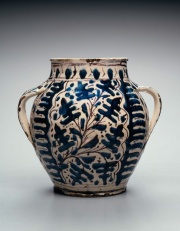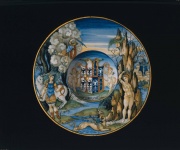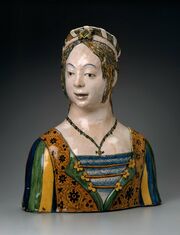Difference between revisions of "Majolica"
Jump to navigation
Jump to search
(username removed) |
|||
| (3 intermediate revisions by 3 users not shown) | |||
| Line 1: | Line 1: | ||
| − | [[File:23.268-CR9747-d1.jpg|thumb|]] | + | [[File:23.268-CR9747-d1.jpg|thumb|Renaissance jar<br>MFA# 23.268]] |
== Description == | == Description == | ||
| + | [[File:41.105-E4334CR-d1.jpg|thumb|Italian plate<Br>MFA# 41.105]] | ||
| + | A type of tin-glazed earthenware first produced on the island of Majorca. The technique was transferred to Italy in the 12th century and later spread slowly throughout Europe. Now, even though several similar methods are used elsewhere in Europe ([[faience|faience]], [[delftware|delftware]]), the term 'majolica' refers only to the tin-glazed pottery made in Italy. The white majolica tin glazes were decorated in blue ([[cobalt|cobalt]]), yellow ([[antimony|antimony]]), red ([[iron|iron]]), green ([[copper|copper]]), and purple ([[manganese|manganese]]). | ||
| − | + | [[File:54.146-E4357CR-d1.jpg|thumb|Bust of a woman<br>MFA# 54.146]] | |
| − | |||
== Synonyms and Related Terms == | == Synonyms and Related Terms == | ||
maiolica | maiolica | ||
| − | == | + | ==Resources and Citations== |
| − | + | * ''Encyclopedia Britannica'', http://www.britannica.com Comment: majolica." Accessed 4 Feb. 2005. | |
| − | |||
| − | |||
| − | |||
| − | |||
| − | |||
| − | |||
| − | * ''Encyclopedia Britannica'', http://www.britannica.com Comment: majolica." | ||
* ''The Bullfinch Guide to Art History'', Shearer West (ed.), Bullfinch Press, Boston, 1996 | * ''The Bullfinch Guide to Art History'', Shearer West (ed.), Bullfinch Press, Boston, 1996 | ||
Latest revision as of 09:13, 17 October 2022
Description
A type of tin-glazed earthenware first produced on the island of Majorca. The technique was transferred to Italy in the 12th century and later spread slowly throughout Europe. Now, even though several similar methods are used elsewhere in Europe (Faience, Delftware), the term 'majolica' refers only to the tin-glazed pottery made in Italy. The white majolica tin glazes were decorated in blue (Cobalt), yellow (Antimony), red (Iron), green (Copper), and purple (Manganese).
Synonyms and Related Terms
maiolica
Resources and Citations
- Encyclopedia Britannica, http://www.britannica.com Comment: majolica." Accessed 4 Feb. 2005.
- The Bullfinch Guide to Art History, Shearer West (ed.), Bullfinch Press, Boston, 1996


